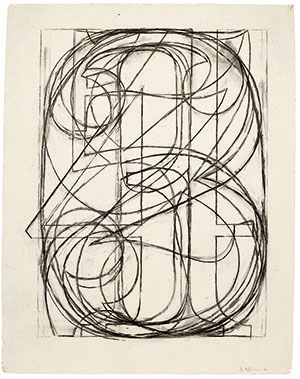Long associated with the New York City art scene of the late 1950s and early 1960s, Jasper Johns has also traditionally drawn substantial interest here in the San Francisco Bay Area, his work featured in several notable public and private collections. Perhaps most famous for his iconic paintings of American flags, Johns has explored related themes of representation featuring subjects as common and everyday as targets, maps, numbers, letters, and stenciled words.
A recently-opened exhibition at SFMOMA, Seeing with the Mind’s Eye, brings together a large collection of these works representing Johns’s nearly sixty year career from 1956 to the present, anchored by key elements from both the artist and the museum’s holdings. The result is a presentation of considerable breadth, illustrating, highlighting, and celebrating the artist’s varied processes, visions, and strategies.
Intrigued by everyday objects and forms that, as the artist put it, are “seen and not looked at, not examined,” Johns’s goal has been to investigate the relationship between art and meaning (hence the title of the exhibition).
In many ways, Johns’s early work, along with those of his contemporaries and collaborators including Robert Rauschenberg, represented a reversal from the then-dominant school of Abstract Expressionism, as articulated by Jackson Pollard and Willem de Kooning, among others. At the same time, Johns was a key influencer in the nascent Pop art and Minimalism movements.
The exhibition offers an essentially chronological journey through Johns’s oeuvre, progressing from his first mature effort (Flag) through a series of drawings, prints, sculptures, and mixed-media paintings. Numbers are prevalent early, not surprising perhaps in hindsight, as Johns’s early career coincided with the launch of what we now recognize as the computer age. We see numbers in monochrome, in outline, as ten-color lithographs, and in reliefs cast from bronze and silver, all asking questions about the relationship between representation and meaning.
Jasper Johns’s connection with the Bay Area began in San Francisco in the spring of 1964 when he attended a performance by musician friend John Cage. From this emerged two paintings on display in the exhibition, Souvenir and Souvenir 2, striking for their unexpected incorporation of objects such as flashlights and mirrors, as well as plates with the artist’s image. Both are now on long-term loan to the SFMOMA.
We also see early examples of Johns’s sculptural and relief work, as always, based on rather mundane objects (light bulbs, bread, shoes, brushes). On display further along is Johns’s Crosshatch series (with strongly distinct strokes), the Catenary works (muted tones highlighted with a string hanging across the painting), Land’s End and Periscope (both in memory of poet Hart Crane), and Johns’s more recent works, including Shrinky Dinks and the Bushbaby (on view for the first time in this exhibition).
Evident always in Johns’s work is a directed sense of exploration, with Johns regularly revisiting familiar themes while varying key elements such as medium, materials, colors, proportions, or the basic configuration. Interesting too is just how obvious Johns’s iterative style of creation is in the finished product. As the artist described in his notebook in 1965, his preferred technique was to “Take an object. Do something to it. Do something else to it…”
For people who only know Johns for his iconic flags, Seeing with the Mind’s Eye offers an exciting new perspective into one of the twentieth centuries seminal artists. Those already familiar with the breadth of Johns’s work will find an intriguing combination of the familiar, the special, and the new.
Plan Your Visit
The San Francisco Museum of Modern Art
151 Third Street (between Mission + Howard)
San Francisco CA 94103
Tel: 415-357-4000
Jasper Johns: Seeing with the Mind’s Eye
On display until February 3, 2013

